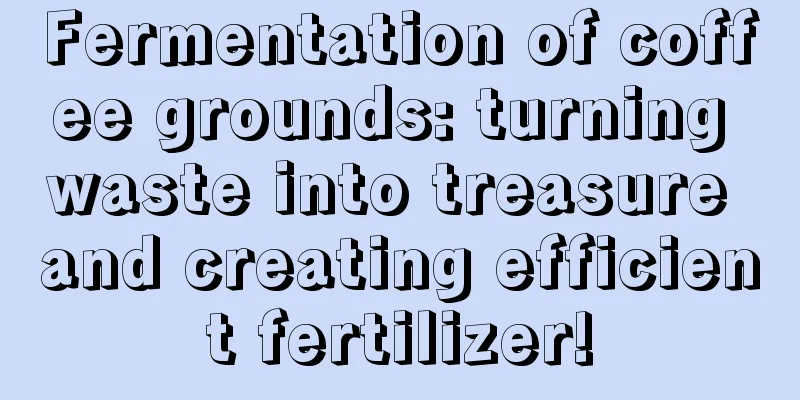Fermentation of coffee grounds: turning waste into treasure and creating efficient fertilizer!

Fermenting coffee grounds: turning waste into treasure and creating efficient fertilizer!With the fast pace of modern life and the prevalence of coffee culture, a large amount of coffee grounds are produced every day. These grounds, which are considered waste, contain huge potential. Through fermentation, coffee grounds can be transformed into high-efficiency fertilizers to achieve resource recycling. This article will introduce the process and advantages of fermenting coffee grounds to make fertilizers. 1. Coffee grounds fermentation processFirst, after collecting a sufficient amount of coffee grounds, they need to be pre-processed. Drying them and grinding them into powder will help improve the subsequent fermentation effect. Next, add an appropriate amount of water to a sealed container and control the humidity. Generally speaking, the humidity should be kept at around 50%. Then, add an appropriate amount of bacteria or compost into the container and mix thoroughly. Common bacteria include anaerobic bacteria, aerobic bacteria, etc. The next step is the process of standing and fermenting. Seal the container and place it at a suitable temperature, generally 20-30 degrees Celsius. During the fermentation process, the organic matter in the coffee grounds will be decomposed by the bacteria and produce a large amount of organic fertilizer. Finally, after the fermentation is completed, the obtained fertilizer can be dried and screened. 2. Advantages of coffee grounds fertilizer2.1 Rich in nutrients: After fermentation, coffee grounds contain rich nutrients such as nitrogen, phosphorus, potassium, etc. These elements are key nutrients necessary for plant growth. 2.2 Suitable pH value: Coffee grounds have a low pH value, which can be further reduced after fermentation. This makes coffee grounds fertilizer an ideal soil conditioner. 2.3 Strong water retention capacity: Due to its fine and porous nature, coffee grounds fertilizer has excellent water absorption and moisture retention capacity. This is very important for plant root growth and water supply. 2.4 Environmental sustainability: Reusing coffee grounds as waste can reduce the negative impact on the environment. At the same time, making coffee grounds fertilizer is also in line with the concept of circular economy and sustainable development. 3. Application of coffee grounds fertilizerCoffee grounds fertilizer is widely used in agriculture, gardening and home planting. In agriculture, coffee grounds fertilizer can be added to the soil as an organic fertilizer, providing nutrients needed by plants and improving soil structure. This helps increase yields, improve quality, and reduce the use of chemical pesticides and fertilizers. In gardening, coffee grounds fertilizer can be applied directly to flowers, vegetables and other plants. It not only promotes plant growth, but also inhibits the occurrence of some diseases and pests. In home planting, mix an appropriate amount of coffee grounds into the soil of flower pots or vegetable gardens, and release nutrients to the plants during daily watering. This is a simple and effective way to use fertilizer. 4. Notes on coffee grounds fertilizer4.1 Control the fermentation process: Coffee grounds fermentation requires good control of humidity, temperature and strain selection. Different conditions will affect the fermentation effect, so they need to be adjusted according to actual conditions. 4.2 Use in moderation: Although coffee grounds fertilizer is rich in nutrients, it should not be used in excess. Excessive application may lead to problems such as soil salinization. 4.3 Pay attention to quality and safety: Choose high-quality, pollution-free coffee grounds, and ensure that external contaminants are prevented from entering during the fermentation and processing process. 5. ConclusionFermenting coffee grounds to make efficient fertilizer is an innovative and sustainable way to recycle resources. By turning waste into valuable resources, we can reduce our dependence on natural resources while improving soil quality and plant growth. In the future, there are many challenges and opportunities waiting for us to explore in promoting the wider application of this technology. |
>>: Is coffee harmful to your health?
Recommend
What are the coffee beans for espresso?
Espresso is a very popular type of coffee with a ...
The world's top coffee beans: 8 of the best to taste
The world's top coffee beans: 8 of the best t...
Shanghai's Internet-famous coffee street is booming
Shanghai's Internet-famous coffee street is b...
Coffee knowledge points: varieties, roasting, brewing methods, caffeine content, etc.
Coffee Varieties Coffee is a beverage made from c...
Coffee 11: A cup of fragrant coffee with endless flavor
The charm of coffee Coffee, a fragrant and delici...
Starbucks hot drinks ranking: the most popular delicious coffee!
Starbucks hot drink rankings: The most popular Lu...
The Difference Between Espresso Beans and Regular Coffee Beans
Definition and production process of espresso bea...
Cold brew coffee has low caffeine and high antioxidant capacity? Research results slap it in the face again!
Click to follow | Daily boutique coffee culture ma...
After grinding the coffee beans, do you boil or brew them?
Two ways to handle ground coffee beans: boiling a...
Coffee bean chewing addiction: exploring the myths and dangers behind it
Coffee bean chewing addiction: Exploring the myth...
Coffee Country: Exploring the Secrets of Coffee Origin
The Secret of Coffee Country's Aroma Coffee, ...
Is it normal for coffee beans to taste sour?
The multiple sources of coffee bean acidity The s...
Jiuchang Street Coffee, unique taste and extraordinary quality
Jiuchang Street Coffee is unique in taste and qua...
Coffee-specific milk powder makes your coffee more fragrant
introduction Coffee is a must-have drink for many...
How to make a cup of hand-poured coffee
You must have encountered a similar problem: you w...









